
The festivals held from September to November are called “autumn festivals”, and you can enjoy unique events such as food and portable shrines all over the country. In this article, we will introduce information on autumn festivals in 2024. Let’s enjoy autumn festivals in Japan.
■Autumn festivals in Japan are celebrations to express gratitude for the harvest.

Autumn festivals in Japan are celebrations to express gratitude to the gods for the harvest of the year’s crops. Autumn is the season when the harvest of various foods, including rice, which is the staple food of the Japanese, and the produce of the mountains, is at its peak, and it is also called the harvest season in Japan. People began to perform music and dance to celebrate the harvest of the crops and to entertain the gods.
You can also enjoy unique events all over the country, such as festivals with the aim of praying for development, peace, and good health, as well as town revitalization and attracting tourists.
■7 Autumn Festival Information for 2024

We will explain in detail the seven Japanese autumn festivals scheduled to be held in 2024, along with their highlights and characteristics. We will also introduce information on the dates of each festival, so if there is an autumn festival that interests you, please be sure to visit it with your family and friends and enjoy it.
Sapporo Autumn Fest – Japan’s largest food event
This is Japan’s largest food festival, held in Sapporo. It is a gourmet event that attracts over 2 million visitors over a period of about 3 weeks, with a total of 300 stalls. You can enjoy Hokkaido gourmet food, including local wine and sake.
The festival site is spread over seven areas, each about 1km long from east to west, so you won’t be able to see everything in one day, so make sure you come back for a second or third day.
Also, in September, the temperature in Hokkaido is around 20 degrees, so it’s a comfortable temperature. Depending on the time of day and the weather, it can get a little chilly, so it’s a good idea to bring a jacket with you.
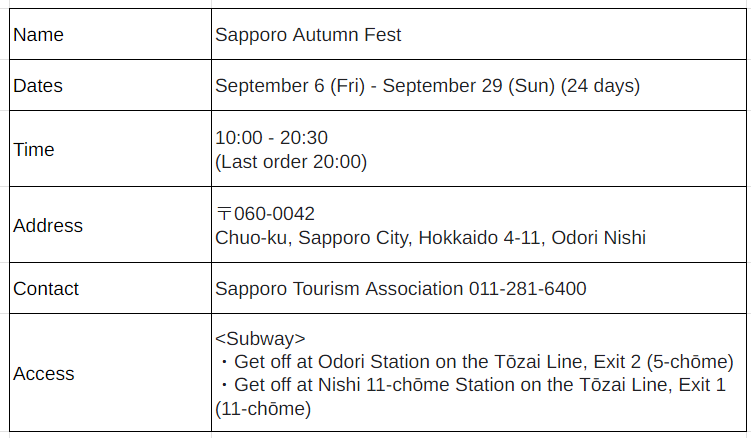
The Tochigi Autumn Festival is held once every two years
The Tochigi Autumn Festival is the largest festival in Tochigi City, and is held once every two years. It is said that the festival originated in 1874, when a festival to celebrate the accession of Emperor Jimmu was held in the grounds of the Tochigi Prefectural Office, and was celebrated with a float. At the Tochigi Autumn Festival, the gorgeous and ornate “Edo-style doll floats” made in the Meiji era parade through the city, and the highlight is the “buttsuke” event, where multiple floats face each other and compete with their music.
At night, the atmosphere changes and the floats are illuminated by paper lanterns, creating a fantastic world. There are also performances of kagura (Shinto music and dance), taiko drumming, local product exhibitions, tea stalls, and more, so you can enjoy the festival all day long, along with the scenery and history of the town of Kuramoto and the Tomoe River.
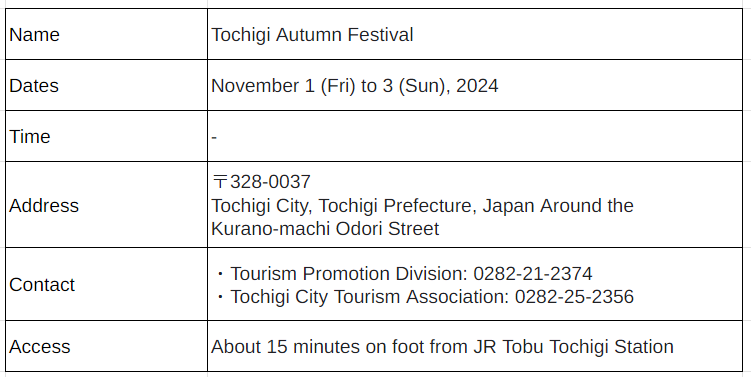
The Tori-no-ichi festival in Asakusa, praying for good luck and business prosperity
The Torinoichi festival is held on the day of the rooster in November, and is a festival for wishing for good luck, happiness and prosperity in business. The day of the rooster refers to the day in the Japanese zodiac when the rooster is born, which occurs once every 12 days. The festival is a time for preparing for the New Year, and it began as a harvest festival where farmers expressed their gratitude to the guardian deity Otorisama.
The specialty is a rake with many good luck charms attached, and it is considered stylish to haggle over the price and give the reduced amount as a “gift” to the shop. Enjoy communicating with the sellers.
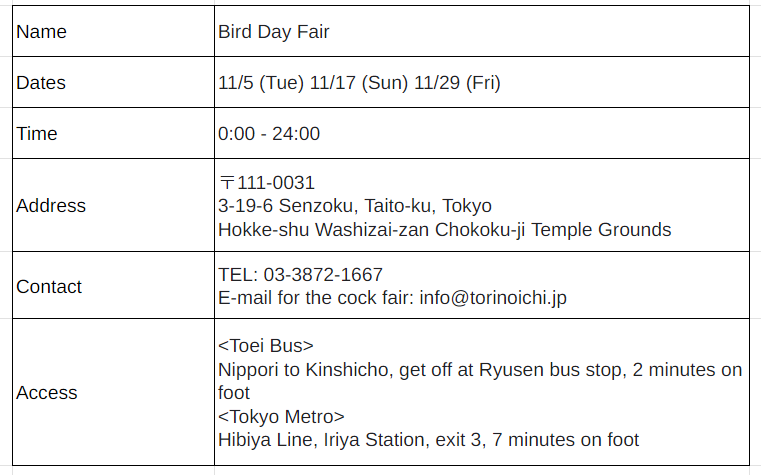
Time travel to the Edo period Shinagawa Shukuba Festival
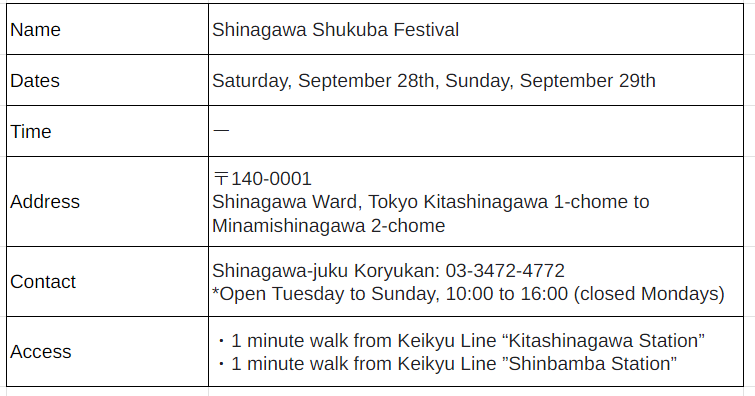
The Shinagawa Shukuba Festival is one of the biggest events in the ward, taking place along a 2km stretch of road. It began as a festival to pass on the traditions and culture of Shinagawa, which was the first post town from Nihonbashi in the Edo period, to the younger generation.
There are lots of highlights, such as the Oiran Procession, which starts at around 4pm on the evening of September 28th, the Shinagawa Shukuba Night, and the Edo-style Procession & Traffic Safety Parade, where people walk around in Edo-period costumes on September 29th.
Participants in the parade are recruited from the general public, and after the parade, participants can enjoy the Shinagawa Shukuba Festival in their costumes, and it will be like a time-slip back to the Edo period.
A procession that evokes Kyoto’s 1,000-year history Jidai Matsuri
The Jidai Matsuri is a grand festival held at Heian Jingu Shrine that began in 1895 to commemorate the 1,100th anniversary of the transfer of the capital to Kyoto. The highlight of the festival is the Jidai Fuzoku Gyoretsu, a procession of around 2,000 citizens dressed in Heian-period style who parade through the streets of Kyoto.
The procession takes about two hours, so if you want to take your time watching, we recommend the paid seating area. Applications for the paid seating area will be accepted from early September on the special website. Check back for more details, which are scheduled to be announced in late August.
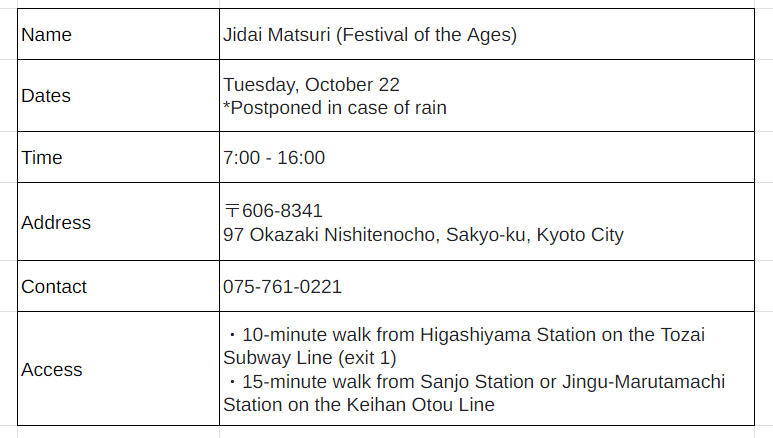
The powerful speed and turning of the floats are a must-see Kishiwada Danjiri Matsuri
The Kishiwada Danjiri Matsuri festival began in the middle of the Edo period and has a history and tradition of over 300 years.
The highlights of the festival are the delicate but powerful decorations on the floats and the “yari-mawashi” turning, where the floats turn at right angles with great force around the corners of the town.
There are dangers involved in watching the yari-mawashi, so be sure to follow the instructions of the staff and avoid entering particularly dangerous areas near the corners.
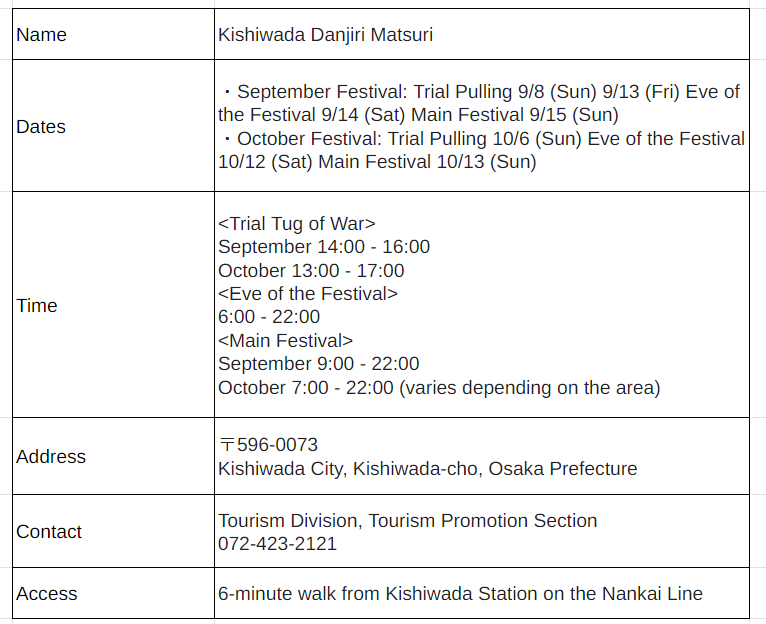
The violent clash of portable shrines and stalls Nada’s Fighting Festival
The Nada Kenka Matsuri (Nada Fighting Festival) is the name given to the Matsubara Hachiman Shrine Autumn Festival held in Himeji City, Hyogo Prefecture, and is said to be the largest of all fighting festivals. It is a historic festival that has been held since before the war, and is famous both in Japan and overseas.
The highlight of the festival is the fierce clash of the three mikoshi (portable shrines) at the foot of Mt. Otabi. This clash is called neriawase, and it brings the tension of the festival to a climax. Afterwards, the seven gorgeous yatai (floats) put on a powerful performance, captivating the large crowd of spectators even more.
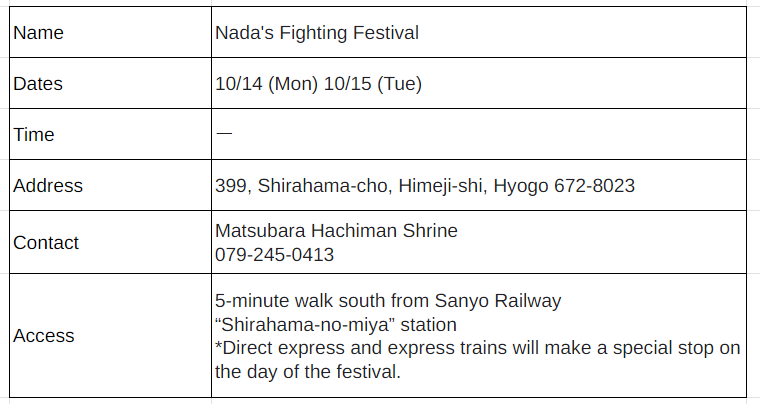
Nada’s Fighting Festival is the name given to the autumn festival held at Matsubara Hachiman Shrine in Himeji City, Hyogo Prefecture, and is said to be the largest of all fighting festivals. It is a historic festival that has been held since before the war, and is famous both in Japan and overseas.
The highlight of the festival is the fierce clash of the three portable shrines at the foot of Mt. Otabi. This clash is called “neriawase” and the tension of the festival reaches its peak. Afterwards, the seven gorgeous floats perform powerful dances, further captivating the large crowd of spectators.
■Summary of Autumn Festival Information for 2024

We have introduced 7 autumn festivals for 2024. There are various autumn festivals held throughout Japan, and we recommend them to those who want to experience Japanese culture and traditions, and those who want to enjoy delicious Japanese food.
In addition, if you understand the meaning of each festival, you will be able to enjoy the festival even more. Please enjoy the autumn festivals in Japan with this article as a reference.
【Q&A】
Q. What is the purpose of the autumn festival?
A. Many autumn festivals are held to give thanks to the gods for a successful harvest. There are also various other purposes, such as passing on the local traditional culture and history to future generations, revitalizing towns, and attracting tourists.
Q. What is a fighting festival?
A. This is a festival in which shrine parishioners and visitors to the shrine compete for and push each other to get a talisman, and in which they predict the year’s harvest. Festivals in which portable shrines and floats are violently crashed into each other are also called “fighting festivals”. The meaning of the crashing into each other differs depending on the festival, so please be sure to participate in the festival to find out.

